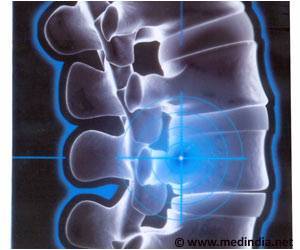Pediatric patients with lumbar disk herniation (LDH) get significant pain relief from surgery on the involved disk only, without spinal fusion.

‘Pediatric patients with lumbar disk herniation (LDH) get significant pain relief from surgery on the involved disk only, performing spinal fusion of the malformed vertebrae doesn't seem to add additional improvement.’





Differences in Lumbar Spine Anatomy for Kids with Herniated DisksTo look for structural malformations that might predispose to herniated disks in children and teens, the researchers analyzed x-rays of 63 patients under age 20 with LDH. The patients were 37 males and 26 females, average age 17 years. All required surgery for severe, disabling back pain that didn't respond to other treatments.
In nearly all patients, x-rays showed at least one type of malformation involving the lumbar spine and sacrum (the base of the spine, located at the rear of the pelvis). "Malformations were completely absent in only three cases," according to Dr. Liu and colleagues.
Some patients had an abnormally "high" pelvis, with long side projections (transverse processes) of the lowest lumbar vertebra (L5). These patients were most likely to have herniation of the disk between the two lowest lumbar vertebrae (L4/L5). In contrast, patients with an abnormally "low" pelvis were more likely to have herniation of the disk between the lumbar spine and sacrum (L5/S1).
Other patients had "transitional vertebrae" between the lumbar spine and sacrum. This malformation also affected the rate of L4/L5 versus L5/S1 herniation, depending on the location of the transitional vertebra.
The researchers also looked at how patients responded to surgery for LDH. In 36 patients, surgery consisted only of removal of the damaged portion of the disk (diskectomy). Twenty-seven patients also underwent fusion (arthrodesis) of the involved vertebrae. In all patients, surgery led to significant reduction in back pain and disability. Outcomes were similar with diskectomy alone versus diskectomy plus arthrodesis.
Advertisement
Based on their findings, Dr. Liu and coauthors write, "Congenital lumbosacral malformations are significantly associated with LDH in children and adolescents." The malformations may be associated with abnormalities of the iliolumbar ligaments--the short, strong ligaments connecting the lumbar spine to the pelvis--leading to impaired stability of the lower spine.
Advertisement
Source-Eurekalert











